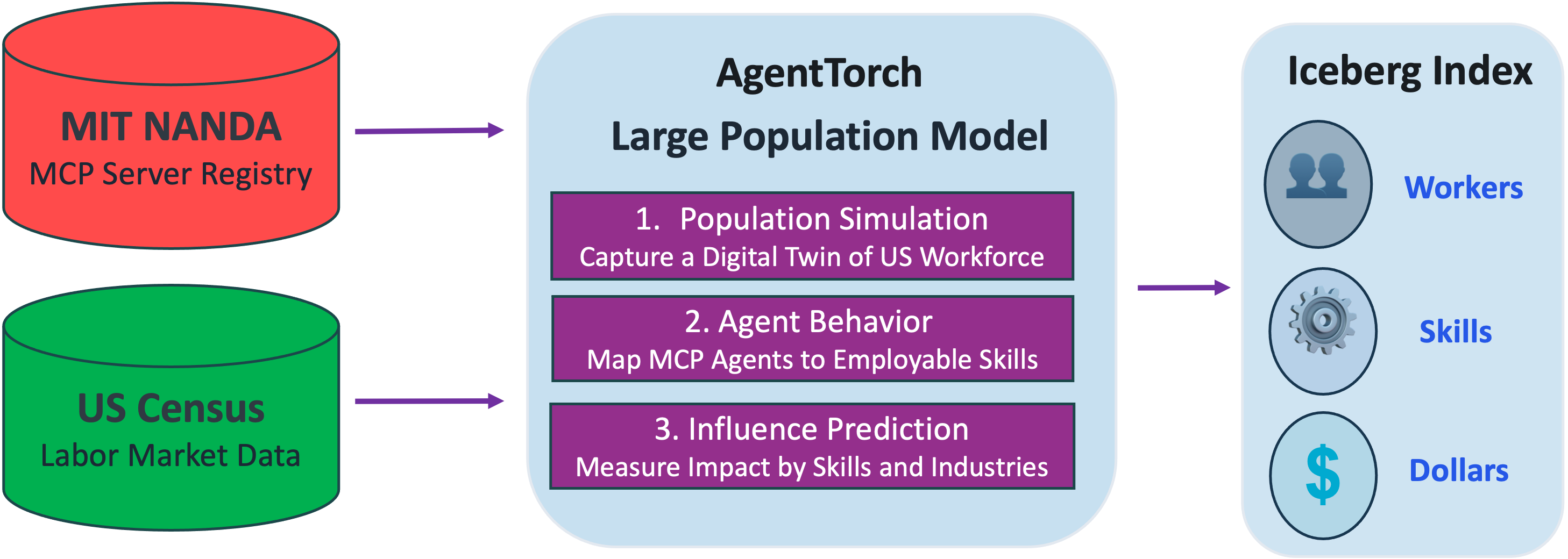Introduction
The emergence of Model Context Protocol (MCP) in late 2024 created a watershed moment in AI's economic impact. By enabling AI agents to connect with external tools and data sources through a standardized protocol, MCP has launched an "Agentic API Economy" where AI systems can autonomously perform valuable tasks that previously required human labor.
We introduce the "Iceberg Index" - the first quantitative metric of our economic susceptibility to Agentic AI automation. This methodology combines large-scale occupational data with real-time MCP server tracking to provide an evidence-based view of AI's growing economic footprint.
Just as an iceberg has a visible portion above water and a much larger portion hidden beneath, our economy has visible jobs that seem immune to automation and a growing portion that's increasingly susceptible to automation. The Iceberg Index measures this hidden portion - the percentage of economic value that can currently be automated through MCP-enabled systems.

Project Iceberg Workflow: How we calculate the Iceberg Index
Our Three-Pillar Methodology
The Iceberg Index is calculated through a comprehensive, data-driven methodology organized around three key pillars:
📊Pillar 1: Capture
We build a comprehensive digital twin of the US labor market, mapping its technological composition and automation susceptibility.
- Merged datasets from O*NET (skills), BLS (employment), and Census (demographics)
- Quantified economic activity across 171 million workers, 32,000+ distinct skills
- Cataloged technology usage across 923 occupations representing $9.4T in labor value
1Technology Intensity Assessment
We analyze each occupation's technological profile by measuring:
- Technology Breadth: Number of distinct technologies used
- Technology Relevance: Centrality to core job functions
- Technology Depth: Sophistication and complexity level
2Skill Taxonomy Development
We classify skills into three primary categories based on automation potential:
- Digital Skills: Programming, data manipulation, technical operations
- Interpersonal Skills: Communication, leadership, collaboration
- Physical Skills: Manual dexterity, spatial awareness, physical presence
🔍Pillar 2: Analyze
We track the MCP server ecosystem to identify which human capabilities are being digitally replicated.
- Monitor MCP server development using MIT's NANDA Registry (currently tracking 13,000+ servers)
- Develop proprietary algorithms to map MCP servers to specific occupations and skills
- Evaluate functional overlap between MCP capabilities and human job requirements
1MCP Server Types
- Information Access: Database/repository connections
- Tool Control: Application/API execution
- Process Automation: Workflow orchestration
- Domain-Specific: Industry functions
2Automation Factors
- Technology Intensity: Technology integration level
- MCP Server Coverage: Capability availability
- Technology Adoption: Cross-industry prevalence
📈Pillar 3: Compute
We calculate the Iceberg Index to quantify the economic transformation driven by agentic AI.
- Utilize our AgentTorch platform with large population models to analyze millions of job-MCP combinations
- Calculate automation potential across three dimensions: economic value, workforce impact, and industry penetration
- Generate time-series forecasts based on MCP server growth trajectories and technical advancements
1Iceberg Index Calculation
We calculate two key metrics:
- Near-term Iceberg Index (11.56%): Economic value automatable in near-term
- Current Surface Index (2.27%): Economic value automatable with current adoption patterns
2Impact Analysis Framework
We analyze the Iceberg Index across three dimensions:
- Economic Value: Dollar value of automatable labor
- Workforce Impact: Workers in susceptible roles
- Industry Penetration: Sectoral automation distribution
Key Metrics
Future Outlook
The Iceberg Index will continue to grow as MCP servers proliferate and AI agents become more capable. Based on current MCP server growth rates and capability improvements, we project significant expansion of automation potential across the economy.
Iceberg API
Access Iceberg Index data programmatically:
Ongoing Research
Project Iceberg continually refines our methodology to improve the accuracy and utility of the Iceberg Index. Our research agenda focuses on expanding both the breadth and depth of automation impact analysis.
1Measurement Enhancement
- Real-time tracking: Live MCP server monitoring
- Regional analysis: Localized Iceberg Indices
- Demographic impact: Effects across population segments
2Applications Development
- Policy simulation: Scenario modeling for decision-makers
- Business intelligence: Industry-specific forecasts
- Global expansion: International market analysis
Through this ongoing research, Project Iceberg aims to provide the definitive measure of AI's economic transformation, helping stakeholders navigate the rapidly changing landscape of work in the age of agentic AI.